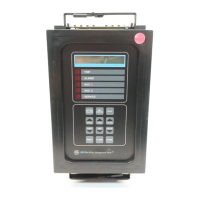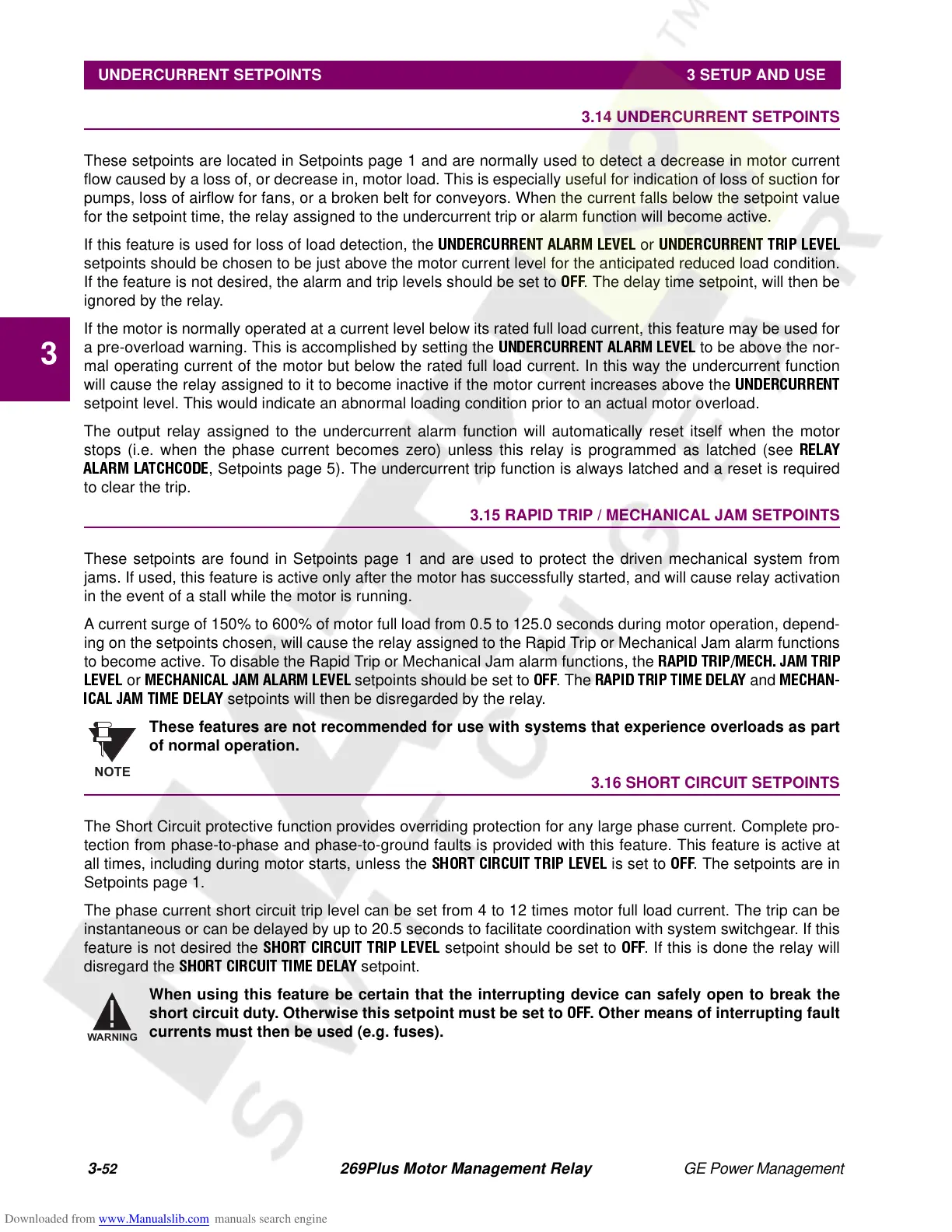3-
52
269Plus Motor Management Relay GE Power Management
UNDERCURRENT SETPOINTS 3 SETUP AND USE
3
3.14 UNDERCURRENT SETPOINTS
These setpoints are located in Setpoints page 1 and are normally used to detect a decrease in motor current
flow caused by a loss of, or decrease in, motor load. This is especially useful for indication of loss of suction for
pumps, loss of airflow for fans, or a broken belt for conveyors. When the current falls below the setpoint value
for the setpoint time, the relay assigned to the undercurrent trip or alarm function will become active.
If this feature is used for loss of load detection, the
UNDERCURRENT ALARM LEVEL
or
UNDERCURRENT TRIP LEVEL
setpoints should be chosen to be just above the motor current level for the anticipated reduced load condition.
If the feature is not desired, the alarm and trip levels should be set to
OFF
. The delay time setpoint, will then be
ignored by the relay.
If the motor is normally operated at a current level below its rated full load current, this feature may be used for
a pre-overload warning. This is accomplished by setting the
UNDERCURRENT ALARM LEVEL
to be above the nor-
mal operating current of the motor but below the rated full load current. In this way the undercurrent function
will cause the relay assigned to it to become inactive if the motor current increases above the
UNDERCURRENT
setpoint level. This would indicate an abnormal loading condition prior to an actual motor overload.
The output relay assigned to the undercurrent alarm function will automatically reset itself when the motor
stops (i.e. when the phase current becomes zero) unless this relay is programmed as latched (see
RELAY
ALARM LATCHCODE
, Setpoints page 5). The undercurrent trip function is always latched and a reset is required
to clear the trip.
3.15 RAPID TRIP / MECHANICAL JAM SETPOINTS
These setpoints are found in Setpoints page 1 and are used to protect the driven mechanical system from
jams. If used, this feature is active only after the motor has successfully started, and will cause relay activation
in the event of a stall while the motor is running.
A current surge of 150% to 600% of motor full load from 0.5 to 125.0 seconds during motor operation, depend-
ing on the setpoints chosen, will cause the relay assigned to the Rapid Trip or Mechanical Jam alarm functions
to become active. To disable the Rapid Trip or Mechanical Jam alarm functions, the
RAPID TRIP/MECH. JAM TRIP
LEVEL
or
MECHANICAL JAM ALARM LEVEL
setpoints should be set to
OFF
.The
RAPID TRIP TIME DELAY
and
MECHAN-
ICAL JAM TIME DELAY
setpoints will then be disregarded by the relay.
These features are not recommended for use with systems that experience overloads as part
of normal operation.
3.16 SHORT CIRCUIT SETPOINTS
The Short Circuit protective function provides overriding protection for any large phase current. Complete pro-
tection from phase-to-phase and phase-to-ground faults is provided with this feature. This feature is active at
all times, including during motor starts, unless the
SHORT CIRCUIT TRIP LEVEL
is set to
OFF
. The setpoints are in
Setpoints page 1.
The phase current short circuit trip level can be set from 4 to 12 times motor full load current. The trip can be
instantaneous or can be delayed by up to 20.5 seconds to facilitate coordination with system switchgear. If this
feature is not desired the
SHORT CIRCUIT TRIP LEVEL
setpoint should be set to
OFF
.Ifthisisdonetherelaywill
disregard the
SHORT CIRCUIT TIME DELAY
setpoint.
When using this feature be certain that the interrupting device can safely open to break the
short circuit duty. Otherwise this setpoint must be set to
OFF
. Other means of interrupting fault
currents must then be used (e.g. fuses).
NOTE
WARNING

